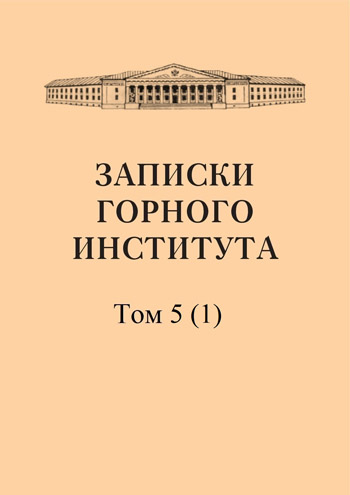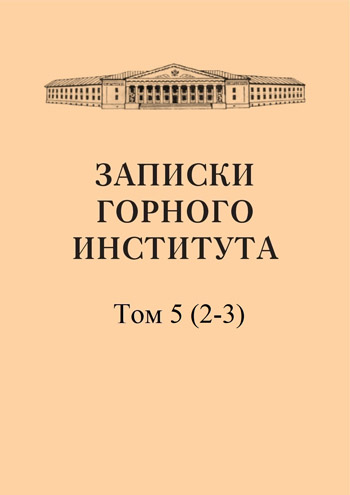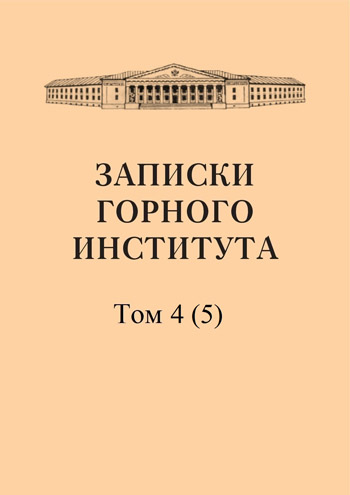-
Date submitted1913-07-29
-
Date accepted1913-09-19
-
Date published1914-01-01
Mine "Yuliya" of the joint-stock company "Siberian Copper"
- Authors:
- V. N. Tomilin
The Yuliya mine, owned by the joint-stock company Siberian Copper (formerly the English Yenissei Copper С° Ltd), is located 90 versts in a straight line to the north-west of the district town of Minusinsk in a mountainous area, at an altitude of about 3—3^(1/2)thousand feet above sea level. The terrain consists of a number of separate rather high hills with relatively steep slopes. “Yuliya” lies almost on the border of the steppe (from the north) and taiga (from the south). As a general rule, the northern slopes of the hills are covered with dense growth of larch and birch, while the southern slopes are either bare or only covered with grass. The vicinity of “Yuliya” is composed mainly of crystalline, often siliceous, highly metamorphosed limestones with very disturbed bedding. In many places, the limestones are intruded and cut by a whole system of individual massifs and dikes of igneous rocks - red syenite porphyries and syenites.
-
Date submitted1913-07-05
-
Date accepted1913-09-16
-
Date published1914-01-01
Collinear transformation of imaginary ray pairs
- Authors:
- E. S. Fedorov
Involutory-collinear transformations are among the most elementary operations of new geometry. But this always means the transformation of real geometric images. The problem of transforming imaginary images, for example, imaginary circles, as it seems, has not been posed and seems incomprehensible. When studying a system of pairs of rays, this problem was presented in all its reality in the following form. If two pairs of rays are given, we take them to be two pairs of tangent parabolas, which is easy to construct, and thus we find a linear primе of pairs of rays whose centers form a straight line, and the pairs of rays themselves are pairs of tangents to the parabola.
-
Date submitted1913-07-19
-
Date accepted1913-09-09
-
Date published1914-01-01
Spherical aggregates of conoprimes
- Authors:
- E. S. Fedorov
One of the very first principles of the new geometry is the theorem according to which projectivity on primes (linear and square) is established by the correspondence of three elements. Therefore, if four arbitrary lines are given on a plane, then each of them, in intersection with three others, gives three points, and this is enough to establish the projectivity of points on all these lines, because on each of them we have three corresponding points. If spherical aggregates are given partly by real, partly by imaginary conoprimes, then from them it is necessary to construct two linear aggregates of the same level, of which for one it is necessary to change the value of the category of conoprimes: take the real for the imaginary and vice versa.
-
Date submitted1913-07-23
-
Date accepted1913-09-18
-
Date published1914-01-01
Symmetrical hexaprimes
- Authors:
- E. S. Fedorov
The most important categories of hexaprimes, or what is commonly called spatial curves of the 3rd order, were derived by Seydewitz and are given in the famous manual by Reye under the names 1) spatial hyperbola, 2) spatial ellipse, 3) parabolic hyperbola and 4) spatial parabola. This note was the result of a task: is it possible to build a hexaprima that has symmetry? The term hexaprima means such a prima of points that is completely and unambiguously determined by six points, and a 3rd order spatial curve is just such a curve. We get three constructions leading to hexaprimes of three types of symmetry (see article).
-
Date submitted1913-07-05
-
Date accepted1913-09-15
-
Date published1914-01-01
Systems of segments and pairs of rays on a plane
- Authors:
- E. S. Fedorov
“In my previous works, I examined a number of geometric systems, the elements of which consist of pairs of points. The simplest and most important of them is the system of parallel vectors, then the system of harmonic segments and vectors, and finally the system of midpoints of harmonic pairs. But in all these systems considered, some limitation is introduced either in the form of vectorality or in the form of a special parameter of the system. Here I mean to consider a system of such elements, given without any restrictions, that is, I imagine that an element of a system on a plane can be an arbitrary pair of its points, which at the same time will form a segment.
-
Date submitted1913-07-16
-
Date accepted1913-09-19
-
Date published1914-01-01
Theorem relating to the circle system
- Authors:
- E. S. Fedorov
This theorem very simply solves the problem, which can be formulated as follows as a problem of elementary geometry (see article). Despite the simplicity of solving it as a problem in a system of circles, it is hardly solvable on the basis of theorems of elementary geometry. It is clear that this theorem can be directly transferred to the system of spheres by replacing the words “circle” with the words “sphere”. To prove it, it is enough to take the central Q R as the axis of rotation. Thus, in the most general form, the problem of finding the centers of spherotions of sphers, which was previously solved through formulas, is resolved.
-
Date submitted1913-07-04
-
Date accepted1913-09-21
-
Date published1914-01-01
Systems of vectors and vectorial pairs of rays
- Authors:
- E. S. Fedorov
In previous works, I developed a vector system in detail. But since vectors essentially represent pairs of points, albeit unequal (initial and terminal) and since correlative rays can be established for each point, it is clear that systems of vectors can be correlative to systems of pairs of rays that can hardly be called anything other than vectorial. But if it is somewhat difficult to talk about vectorial pairs of rays on a plane, then, for the sake of complete clarity, I prefer to establish such a sequence of systems that are part of all the linear elements of this system.
-
Date submitted1913-07-03
-
Date accepted1913-09-17
-
Date published1914-01-01
New interpretation of rays
- Authors:
- E. S. Fedorov
We have come to the conclusion that the system of rays can be introduced into the general series of geometric systems, and we can bring it into a general correlative connection. However, this system no longer belongs to the number of independent ones, but to the number of systems limited by a certain parameter, for which we must recognize a certain extra-ray, constant for all linear primes just as we have a similar system of points with a parameter point included in all linear primes of this system.
-
Date submitted1913-07-30
-
Date accepted1913-09-23
-
Date published1914-01-01
Systems of circles on a sphere
- Authors:
- E. S. Fedorov
Any general collection of circles will not differ from the collection of circles of the previous system, but will constitute only half of the collection of this system, and the linear primes and seconds of ordinary circles will remain the same for this system; but the linear collections of vector circles of the previous system will no longer be such for this system , because the tangent linear primes of the previous one are no longer the linear primes of this system. It is easy to prove that in this system there are no collections of vector circles at all; they cannot even be specified. In fact, if I think about, for example, a right vectorial circle, then diametrically opposite to it is already a left vectorial circle; in essence, two vectorial circles are obtained, which completely and unambiguously determine their linear primacy on the sphere; it is clear that in her presence it is impossible to set a third, arbitrary circle; in general, it would no longer be part of a certain linear prima.
-
Date submitted1913-07-17
-
Date accepted1913-09-30
-
Date published1914-01-01
Linear collections of vectors in space
- Authors:
- E. S. Fedorov
The article “A simple and more accurate representation of points in 4-dimensional space on a plane using vectors” not only examines in detail the system of vectors on the plane, but also indicates the basis for constructing a linear prima of vectors in space based on two data, namely, that this linear prima consists of segments of the generating hyperbolic paraboloid, enclosed between two guides, of which one is the line of initial points, and the other is the line of end points, and the construction itself can be done by decomposing two given vectors into a component along three coordinate axes and constructing linear parallel vectors from the components; three vectors with a common starting point, but parallel to the coordinate axes, no matter what directions we choose for the latter, are the constituent vectors of a linear prima; the end point of the latter is on the line of end points.
-
Date submitted1913-07-18
-
Date accepted1913-09-23
-
Date published1914-01-01
Вывод некоторых формул, относящихся к обработке металла прокаткой
- Authors:
- Unknown
Будем рассматривать случай, когда прокатывается брусок с прямоугольным сечением. 1. Определим в зависимости от давления на валки давление на единицу поверхности металла, предполагая это давление равномерным. Иначе говоря, определим среднее давление на единицу поверхности металла (см. статью). 2. Вычислим механическую полезную работу при одном проходе бруска между валками. Под полезной работой мы понимаем здесь работу, которая затрачивается собственно на изменение формы бруска.
-
Date submitted1913-07-11
-
Date accepted1913-09-24
-
Date published1914-01-01
A note on the lower tertiary deposits of the Turgai district
- Authors:
- N. G. Kassin
In the summer of 1912, the author of the note visited the middle and lower part of the Kara-Turgai river basin, which occupies the central part of the Turgai district. On the way, he examined a fairly large number of outcrops, and in some of them a rather rich fauna was encountered. The results of these observations are presented in this note. The central part of the Turgai district of the Turgai region has so far been visited by very few researchers and travelers.
-
Date submitted1913-07-16
-
Date accepted1913-09-07
-
Date published1914-01-01
The first experimental observation of an asymorphic regular system
- Authors:
- E. S. Fedorov
The use of X-rays enabled V.L. Bragg (and his father) to get the means that led to conclusions extremely important for the theory of crystal structure. These conclusions are partly unexpected, at least in the sense that it was expected to see the centers of chemical particles at the points of regular systems, while the experiments of the named scientist led to the conclusion that these are the centers of atoms. Thanks to this, in substances of the simplest chemical composition, special regular systems of points are obtained, and the centers of symmetry are occupied by individual atoms, as if the atoms themselves also have high symmetry.
-
Date submitted1913-07-16
-
Date accepted1913-09-21
-
Date published1914-01-01
Dunits of Vasil'evo - Shaitanskay dacha in the Urals
- Authors:
- D. Misharev
Shaitanskaya dacha is located on the very ridge of the southern part of the Middle Urals, included in the 138th sheet of the general geological map of Russia. From the south, the dacha is washed by the Chusovaya River, which serves as a natural border with the Revdinskaya dacha; Bilimbaevskaya dacha is adjacent to the north and west, and from the east Verkh-Isetskaya. The western chain consists of separate mountains: “Volchikha” and three “Magnetic” ones. The first is composed of gabbro, and the rest of amphibolites. The eastern chain, known as the “Crests”, is a purely serpentine ridge, in the very center of which there are outcrops of primary igneous rocks of ultrabasic magma: dunites, pyroxenites interconnected by transitional rocks. Let us classify dunites into the oline subgroup (see article).
-
Date submitted1913-07-04
-
Date accepted1913-09-22
-
Date published1914-01-01
On the structure of diamond crystals according to Bragg
- Authors:
- E. S. Fedorov
This note is motivated primarily by the desire to present Bragg's final conclusion in a more visual form; and then, in view of the complete originality of this conclusion and the rather sharp discrepancy with our previous ideas about the structure of particles, there was a desire to decide whether it was possible to reconcile it with them. Thinking about the arrangement of atoms, we can easily understand that it is of two kinds. Some atoms occupy the positions of the centers of rhombic dodecahedrons, others occupy the positions of such four trigonal vertices of the dodecahedron that together they belong to the tetrahedron. It is this arrangement that determines the hexakis-tetrahedral type of symmetry, and although the location of the centers of some particles corresponds to the dodecahedral structure, the situation is changed by the arrangement of other atoms.
-
Date submitted1913-07-30
-
Date accepted1913-09-15
-
Date published1914-01-01
New crystallographic projections
- Authors:
- E. S. Fedorov
Strictly speaking, projections can be constructed as many as geometric systems of the second stage, that is, an unlimited number, and if I now want to mention such as new crystallographic ones, it is solely because they represent a kind of convenience for solving certain crystallographic problems not delivered by other projections. Here I mean those projections that are obtained from the linear and gnomonic ones if they are subjected to transformation by inverse radii, which is why they can be called grammatic and gnomocyclic, respectively.
-
Date submitted1913-07-08
-
Date accepted1913-09-04
-
Date published1914-01-01
Determination of network densities of monoclinic, hypohexagonal and trigonaloid complexes without displacements.
- Authors:
- E. S. Fedorov
In previous works, methods for such a determination were given using the tables of Sokolov and Artem'ev, with the exception of the cases listed in the title, unless the pole corresponding to the double axis of symmetry is also the pole of the face (1000). In all these cases, it is assumed that certain displacements are made to determine density of the main belt faces. In this note I will show that for these cases you can do without a displacement (see article).
-
Date submitted1913-07-10
-
Date accepted1913-09-21
-
Date published1914-01-01
Elementary derivation of the formula for determining the density of faces and edges of a hypohexagonal-isotropic complex
- Authors:
- E. S. Fedorov
Though from the previous note, one can see how important, when initially studying the cristallography, is the derivation of special simple formulas for determining the density of isotropic complexes, cubic and hypohexagonal. The beginners are best and most easily acquainted with the technique of determining densities from tables precisely on examples of isotropic complexes, since simple formulas give perfect control to the determinations made and immediately familiarize them practically with the degree of accuracy or rather inaccuracy of graphical operations.
-
Date submitted1913-07-07
-
Date accepted1913-09-26
-
Date published1914-01-01
Pascal's theorem and its closest analogues on the plane and in space
- Authors:
- E. S. Fedorov
Pascal’s theorem underlies the doctrine of conoprimes, expressing their fundamental property that is completely and unambiguously determined by five elements. It can be expressed in a modern generalized form (see article). This expression clearly demonstrates the deep organic connection of every sixth element with the other five that determine conoprima. A simpler analogue of this theorem can be the well-known theorems expressing the fundamental properties of spheroprimes and spheroseconds.
-
Date submitted1913-07-26
-
Date accepted1913-09-30
-
Date published1914-01-01
Polar relations of imaginary triangles and tetrahedrons
- Authors:
- E. S. Fedorov
The known properties of the gnomonic projections of trigonaloid crystals prompted me about the presence of the relationships mentioned in the title that seemed paradoxical to me. For the case under consideration, the theory of poles and polars unfolds in its usual form: two points are the poles of two polars and, in turn, determine the straight line-polar of the point of intersection of these polars. Each vertex of a trigon has a polar opposite side, etc., and in no case there is a point through which its polar would pass, as it occurs in the case for imaginary projective conjectures (see article).
-
Date submitted1913-07-18
-
Date accepted1913-09-10
-
Date published1914-01-01
Hexasecond, pentaprima and pentasecond planes
- Authors:
- E. S. Fedorov
The content of this note is a direct consequence of the previous one. It contains a theorem that makes it possible to construct a hexasecond using seven arbitrary points. Since the hexasecond is a positional image and is correlatively transferred to the entire geometry of the system, then the construction of a hexasecond of planes based on seven data is implied by itself. But if only six planes are given, then the extraplane is always, like the seventh, at our disposal and is not included in the count as the only one of its kind.
-
Date submitted1913-07-26
-
Date accepted1913-09-10
-
Date published1914-01-01
In memory of Ivan Petrovich Dolbnya
- Authors:
- Unknown
In the preface of the collected works of I. P. Dolbnya published in French by order of the Council of the Mining Institute of Empress Catherine II under the title “Oeuvres mathematiques de Jean Dolbnia,” the famous French mathematician Gaston Darboux said, in particular: ""... Most of his works were published in French in the Recueils des mathematiques and mainly in the Bulletin des sciemes mathematiques. By deciding to compare them in volume and present them as a single whole, the Mining School provided a real service to mathematical research. Dolbnya's work is a credit to his country.


